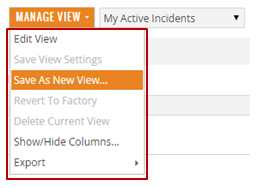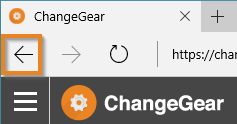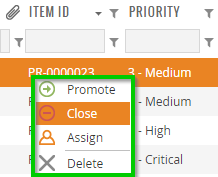Enabling Accessibility
Serviceaide Software complies with the Section 508 Workforce Rehabilitation Act Amendment to allow keyboard accessibility to all ChangeGear features.
To enable all accessibility features implemented in ChangeGear, users who are granted the appropriate privledges by the administrator can enable the user profile accessibility setting through either 1) the Desktop Client or 2) the Web Client.
Enabling Accessibility
To Enable Accessibility via the Web Client:
-
Log-in to the ChangeGear Web client.
-
Navigate to and select the user name in the top right corner of the page to open the User Profile window.
-
Check the Enable Accessibility box at the bottom of the User Profile.
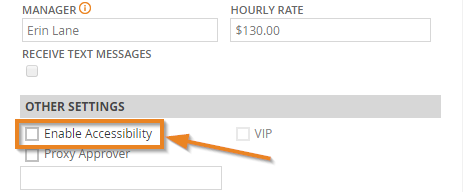
-
Log-out of ChangeGear.
When you log back in, the special keystroke accessibility will be in effect.
Keystroke Navigation
The following table serves as a quick reference guide for the typical keystroke combinations used for the navigation and selection of items.
Note: Refer to the Exceptions section for navigation settings that do not necessarily follow those outlined below.
Primary Controls
|
Keystroke(s) |
Description |
Notes |
|
Tab / Shift+Tab |
Navigates forward and backwards through items |
|
|
Enter |
Selects item |
|
|
Space bar <OR> Alt+
|
Enters/Opens "simple list" drop-down menu. A "simple list" consists of a single layer of selections:
Lists with multiple layers behave differently. See Multi-Level Drop Downs in the Exceptions section. |
Some items may also be selected by Space bar. For example, toggling between Generally speaking, however,Entershould be used for item selection. |
|
Escape |
Exits/Closes the following:
|
|
|
Alt+F4 |
Closes secondary window |
Examples of secondary ChangeGear windows:
|
|
|
Navigates up and down the ticket grid and drop-down menus. |
Once you navigate to the grid via Tab or Shift+Tab, use the arrow keys to select a ticket. Navigate out of the Ticket List by pressing Tab or Shift+Tab. Drop-down example:
|
Secondary Controls
|
Keystroke(s) |
Description |
Notes |
|
Backspace |
Behaves as the standard web page "Back Arrow" to navigate back to the previous web page.
|
Typically used to exit form the Self-Service Portal and Service Catalog Portal pages/ |
|
Alt+M |
Opens the Context Menu when inside a grid with a ticket in focus.
|
Use Tab and Shift+Tab to move focus within the menu. PressEscto close. |
|
Ctrl+Shift+G |
Directly navigates focus from Grid Viewto the more compact Ticket View. This allows for Multiple Ticket functionality. |
See Exceptions: Multiple Ticket Operation for details. |
The above tables cover the majority of the ChangeGear keystroke navigation. However, exceptions exist which do not follow the typical keystroke rules:
Exceptions
-
Shifting focus within the "Drop Down" Module Menu requires Shift+Tab and Tab rather than the up
 and down
and down  arrows.
arrows. -
Multi-Level Drop Downs require the up
 and down
and down  arrows rather than Alt+
arrows rather than Alt+ or Space bar to open.
or Space bar to open. -
Navigating in the Service Catalog Module uses arrows rather than tabbing to move to the edit and delete icons.
-
Ticket selection and navigation when using Multiple Ticket functionality.
-
Drop-down calendar navigation applies particular implementation of Home, End, Page-Up, Page-Down, Esc, and the arrow keys.
Module Menu Navigation
The Module Menu (Drop-Down Module Lust) uses Shift+Tab and Tab to move up and down the selections.
To open the Module Menu, navigate to the Module Menu icon ![]() and press Enter.
and press Enter.
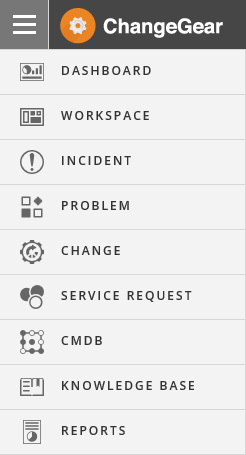
Rather than use the arrow keys to move the focus along the list, press Tab or Shift+Tab.
Note: To close the Module Navigation Page, navigate focus back to the Module Menu icon  and press Enter.
and press Enter.
Multi-Level Drop-Downs
A Multi-Level Drop-Down opens using the up  and down
and down  arrows rather than Alt+
arrows rather than Alt+ or Space bar used for simple lists.
or Space bar used for simple lists.
The up  and down
and down  arrows also navigate the list while the left
arrows also navigate the list while the left  and right
and right  arrows toggle layers open or closed.
arrows toggle layers open or closed.
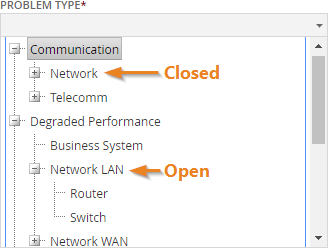
Service Catalog Module Exception
Once you have opened the Service Catalog Module, Shift+Tab or Tab to a selection (Accounts and Password, Business Applications, etc.) then use the left  and right
and right  arrows to shift focus to edit or delete. Press Enter to select.
arrows to shift focus to edit or delete. Press Enter to select.
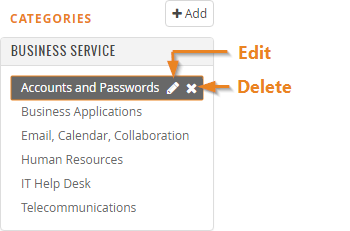
Multiple Ticket Operation
Shifting focus to the Ticket View (Ctrl+Shift+G) changes the ticket selection keystrokes to allow for multiple ticket selection functionality. Keystrokes to navigate the ticket list change from Shift+Tab and Tab to the up  and down
and down  arrow keys.
arrow keys.
Note: Focus must rest within the Grid View for Ctrl+Shift+G to redirect focus to the Ticket View.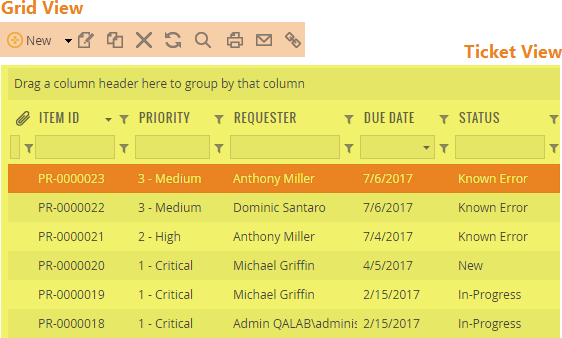
Once in the Ticket View:
To Select Multiple Tickets:
-
Use the up
 and down
and down  arrow keys to place focus on a ticket and press Space bar.
arrow keys to place focus on a ticket and press Space bar. -
Use the up
 and down
and down  arrow keys to place focus on a second ticket and press Space bar. Note that both tickets are now highlighted.
arrow keys to place focus on a second ticket and press Space bar. Note that both tickets are now highlighted. -
Continue process until all desired tickets have been selected.

To exit the Ticket View (and disable multiple selection operation), press Tab or Shift+Tab.
Drop-Down Calendar Navigation
The drop-down calendars found in both the Announcement Portal and in general date/time fields (i.e. a ticket's Due Date) use the arrow keys and Home, End, Page Up, Page Down, and Esc to move focus to specific dates.
Announcement Portal Calendar Drop-Down
To open the Announcement Portal Drop-Down Calendar:
-
Tab (or Shift+Tab) to
 and press Enter.
and press Enter.
To Place Focus Within the Drop-Down Calendar:
-
Tab once to
 and then once more.
and then once more.
Now use the keystroke navigation described in the table below.
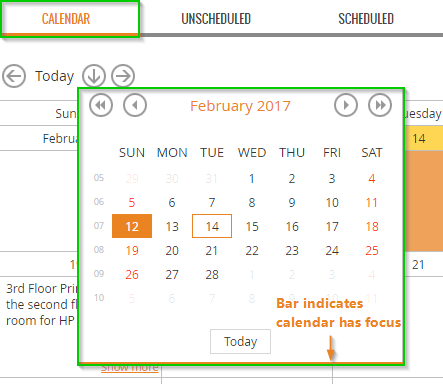
Date/Time Calendar Drop-Down
To open a date/time calendar drop-down typically found in most forms, Tab to the date field (i.e. Due Date) and press Alt+ . This will automatically place focus inside the calendar and allow date navigation as described in the table below.
. This will automatically place focus inside the calendar and allow date navigation as described in the table below.
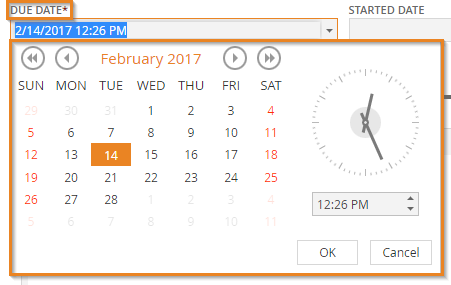
Calendar Keystroke Table
|
Key Combination |
Action (when no date selected) |
Action (when date selected) |
|
Left Arrow |
Selects the current day |
Moves selection to previous day |
|
Right Arrow |
Selects the current day |
Moves selection to the next day |
|
Up Arrow |
Selects the current day |
Moves selection one weekback |
|
Down Arrow |
Selects the current day |
Moves selection one weekback |
|
Page Up |
Selects the current day |
Moves selection one monthback |
|
Page Down |
Selects the current day |
Moves selection one monthforward |
|
End |
Selects the lastday of the current month |
Moves selection to the lastday of the month |
|
Home |
Selects the firstday of the current month |
Moves selection to the first day of the month |
|
Esc |
Cancels changes & closes calendar |
Cancels changes & closes calendar |
|
Enter |
Applies changes |
Applies changes |

 and
and  in the Dashboard.
in the Dashboard.